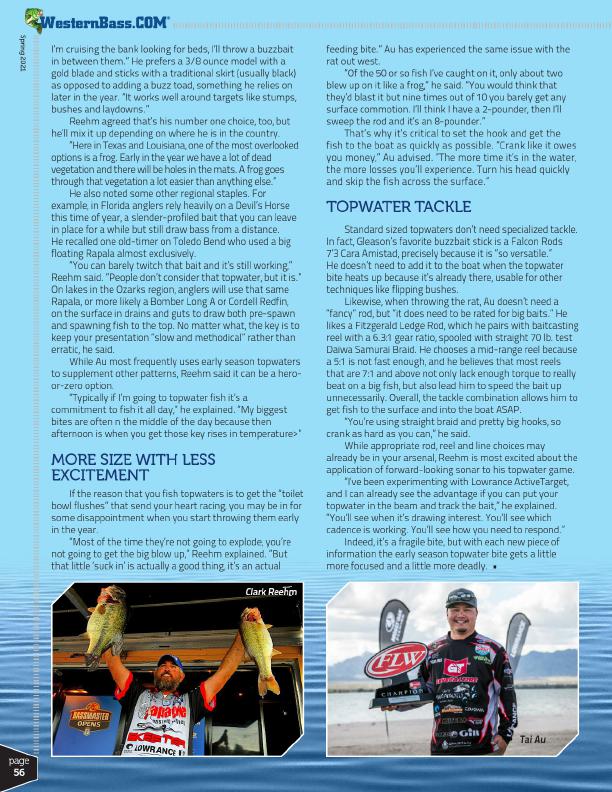
Spring 2021
®
I’m cruising the bank looking for beds, I’ll throw a buzzbait in between them.” He prefers a 3/8 ounce model with a gold blade and sticks with a traditional skirt (usually black) as opposed to adding a buzz toad, something he relies on later in the year. “It works well around targets like stumps, bushes and laydowns.”
Reehm agreed that’s his number one choice, too, but he’ll mix it up depending on where he is in the country.
“Here in Texas and Louisiana, one of the most overlooked options is a frog. Early in the year we have a lot of dead vegetation and there will be holes in the mats. A frog goes through that vegetation a lot easier than anything else.”
He also noted some other regional staples. For example, in Florida anglers rely heavily on a Devil’s Horse this time of year, a slender-profiled bait that you can leave in place for a while but still draw bass from a distance. He recalled one old-timer on Toledo Bend who used a big floating Rapala almost exclusively.
“You can barely twitch that bait and it’s still working,” Reehm said. “People don’t consider that topwater, but it is.” On lakes in the Ozarks region, anglers will use that same Rapala, or more likely a Bomber Long A or Cordell Redfin, on the surface in drains and guts to draw both pre-spawn and spawning fish to the top. No matter what, the key is to keep your presentation “slow and methodical” rather than erratic, he said.
While Au most frequently uses early season topwaters to supplement other patterns, Reehm said it can be a hero- or-zero option.
“Typically if I’m going to topwater fish it’s a commitment to fish it all day,” he explained. “My biggest bites are often n the middle of the day because then afternoon is when you get those key rises in temperature>”
MORE SIZE WITH LESS EXCITEMENT
If the reason that you fish topwaters is to get the “toilet bowl flushes” that send your heart racing, you may be in for some disappointment when you start throwing them early in the year.
“Most of the time they’re not going to explode, you’re not going to get the big blow up,” Reehm explained. “But that little ‘suck in’ is actually a good thing, it’s an actual
Clark Reehm
feeding bite.” Au has experienced the same issue with the rat out west.
“Of the 50 or so fish I’ve caught on it, only about two blew up on it like a frog,” he said. “You would think that they’d blast it but nine times out of 10 you barely get any surface commotion. I’ll think I have a 2-pounder, then I’ll sweep the rod and it’s an 8-pounder.”
That’s why it’s critical to set the hook and get the fish to the boat as quickly as possible. “Crank like it owes you money,” Au advised. “The more time it’s in the water, the more losses you’ll experience. Turn his head quickly and skip the fish across the surface.”
TOPWATER TACKLE
Standard sized topwaters don’t need specialized tackle. In fact, Gleason’s favorite buzzbait stick is a Falcon Rods 7’3 Cara Amistad, precisely because it is “so versatile.” He doesn’t need to add it to the boat when the topwater bite heats up because it’s already there, usable for other techniques like flipping bushes.
Likewise, when throwing the rat, Au doesn’t need a “fancy” rod, but “it does need to be rated for big baits.” He likes a Fitzgerald Ledge Rod, which he pairs with baitcasting reel with a 6.3:1 gear ratio, spooled with straight 70 lb. test Daiwa Samurai Braid. He chooses a mid-range reel because a 5:1 is not fast enough, and he believes that most reels that are 7:1 and above not only lack enough torque to really beat on a big fish, but also lead him to speed the bait up unnecessarily. Overall, the tackle combination allows him to get fish to the surface and into the boat ASAP.
“You’re using straight braid and pretty big hooks, so crank as hard as you can,” he said.
While appropriate rod, reel and line choices may already be in your arsenal, Reehm is most excited about the application of forward-looking sonar to his topwater game.
“I’ve been experimenting with Lowrance ActiveTarget, and I can already see the advantage if you can put your topwater in the beam and track the bait,” he explained. “You’ll see when it’s drawing interest. You’ll see which cadence is working. You’ll see how you need to respond.”
Indeed, it’s a fragile bite, but with each new piece of information the early season topwater bite gets a little more focused and a little more deadly. •
page 56
Tai Au